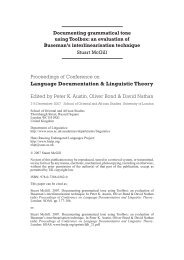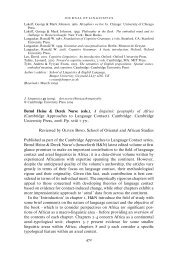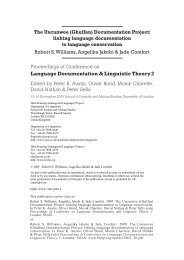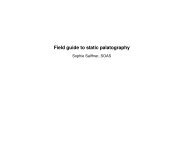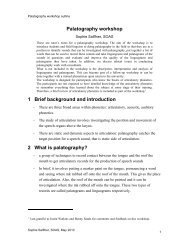Language Documentation & Linguistic Theory 2 - Hans Rausing ...
Language Documentation & Linguistic Theory 2 - Hans Rausing ...
Language Documentation & Linguistic Theory 2 - Hans Rausing ...
You also want an ePaper? Increase the reach of your titles
YUMPU automatically turns print PDFs into web optimized ePapers that Google loves.
Gender and person markers in Cicipu discourse: ‘non-topical’and ‘topical’ anaphoric agreement 1STUART MCGILLSchool of Oriental and African Studies1. INTRODUCTIONOver the last few decades linguists have made considerable progress in theirunderstanding of agreement markers/incorporated pronouns. One of the mostimportant theoretical contributions has been Bresnan and Mchombo‘s (1987)distinction between grammatical agreement and anaphoric agreement, and theassociation of the latter with topical referents. This association between anaphoricagreement and topicality has largely gone unchallenged, and is frequentlyrepeated in the typological literature. The aim of this paper is to present data fromthe agreement system of Cicipu (Kainji, Nigeria) which shows that topicality isnot necessarily derivative of the distinction between grammatical and anaphoricagreement, but is instead an independent dimension along which anaphoricagreement markers can be classified.The paper is structured as follows: section 2 questions the assumption thatanaphoric agreement markers must always have topical referents; section 3 thenintroduces the two paradigms of agreement in Cicipu, gender and person; whilesection 4 considers their distribution across a corpus of approximately 12,000clauses. We find that both gender and person markers may take part ingrammatical and anaphoric subject agreement, with the person markers associatedwith referents that are discourse-topical and/or animate.2. AGREEMENT MARKERS AND TOPICALITYFor languages with optional agreement, the presence of agreement morphology isoften correlated with the topicality of the controller referent. 2 A well-known caseis object agreement in the Bantu languages. Bresnan and Mchombo (1987)describe the asymmetries between (obligatory) subject and (optional) objectagreement in the Bantu language Chicheŵa, and provide an analysis framed inLexical-Functional Grammar (LFG). They make the distinction betweenGRAMMATICAL AGREEMENT, where the agreement marker is a redundant affixexpressing the gender of a co-occurring subject NP (e.g. (1a) for a Cicipuexample), and ANAPHORIC AGREEMENT, in which case the agreement marker is an1 This paper is based on my PhD thesis, submitted to the School of Oriental and African Studies.2The controller is the constituent (usually an NP) ‘controlling’ the agreement morphologydisplayed on the agreement ‘target’ (Corbett 2006).221



